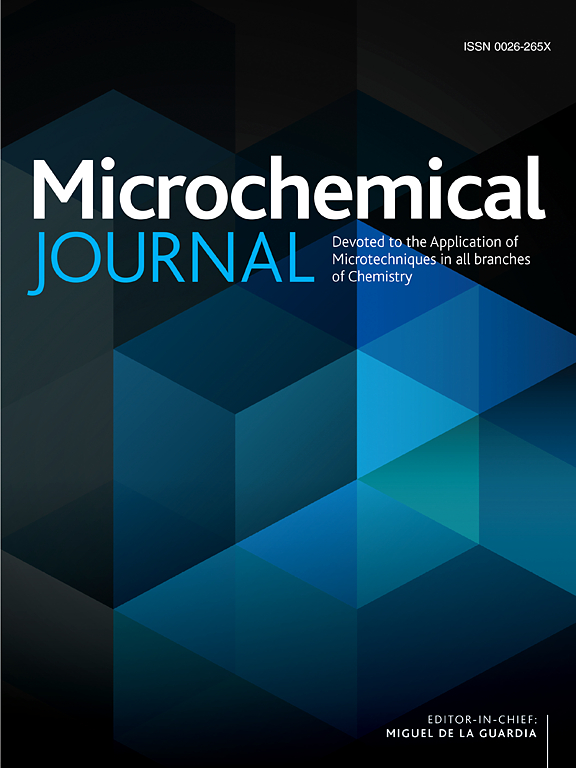利用高光谱成像技术在模拟浅滩环境中检测和分类微塑料
IF 4.9
2区 化学
Q1 CHEMISTRY, ANALYTICAL
引用次数: 0
摘要
微塑料污染对全球环境构成威胁,但传统的检测方法存在效率低下和单点测量的局限性。高光谱成像(HSI)提供了一种很有前途的替代方案,但在复杂的浅滩环境中面临挑战,其中土壤-水基质和可变微塑料浓度使检测复杂化。但现有的HSI研究主要集中在单一环境矩阵上,忽略了浅滩和分布状态对光谱特征的影响。本研究通过开发一种非破坏性、高效的基于hsi的方法来解决这些空白,该方法可以在两种不同浓度的模拟浅滩环境中检测和分类0.5毫米微塑料。对于高浓度样品,本研究采用Otsu图像分割得到二值掩模,结合SG平滑和SNV预处理进行光谱特征提取。此外,根据微塑料的物理特性进行了密度和光谱相关分析。本研究分别构建了基于光谱信息和空间与光谱信息融合的两类模型,结果表明,光谱-空间联合模型具有较好的性能,精度达到99.52%。在低浓度样本检测中,采用改进的基于第二主成分的图像分割方法。实验表明,MRCNN模型在低浓度样品检测中准确率达到93.85%。在引入通道注意机制后,这一准确率进一步提高到96.09%。本研究表明,即使在不同的浓度条件下,高光谱成像技术也可以有效地对浅滩环境中的微塑料进行分类。采用空间-光谱联合建模方法结合通道关注机制,实现了三种微塑料样品的精确区分,从而为微塑料污染监测提供了一种新的技术手段。本文章由计算机程序翻译,如有差异,请以英文原文为准。

Detection and classification of microplastics in simulated shoal environments using hyperspectral imaging technology
Microplastic pollution poses a global environmental threat, yet conventional detection methods suffer from inefficiency and single-point measurement limitations. Hyperspectral imaging (HSI) offers a promising alternative but faces challenges in complex shoal environments where soil-water matrices and variable microplastic concentrations complicate detection. But existing HSI studies focus on single-environment matrices, neglecting shoals and the impact of distribution states on spectral signatures. This study addresses these gaps by developing a non-destructive, efficient HSI-based method to detect and classify 0.5 mm microplastics in simulated shoal environments under two different concentration scenarios. For high-concentration samples, the study employed Otsu image segmentation to obtain binary masks, combined with SG smoothing and SNV preprocessing for spectral feature extraction. Furthermore, density and spectral correlation analysis was performed based on the physical characteristics of the microplastics. This study constructed two types of models based on spectral information and the integration of spatial and spectral information, respectively, with results demonstrating superior performance of the spectral-spatial joint model, achieving an accuracy of 99.52 %. In the detection of low-concentration samples, an improved image segmentation method based on the second principal component was employed. The experiment revealed that the MRCNN model achieved an accuracy of 93.85 % in the detection of low-concentration samples. This accuracy was further enhanced to 96.09 % upon the introduction of the channel attention mechanism. This study demonstrates that hyperspectral imaging technology can effectively classify microplastics in shoal environments, even under varying concentration conditions. By employing a spatial-spectral joint modeling approach in conjunction with a channel attention mechanism, accurate differentiation of three types of microplastic samples was achieved, thereby offering a novel technological means for monitoring microplastic pollution.
求助全文
通过发布文献求助,成功后即可免费获取论文全文。
去求助
来源期刊

Microchemical Journal
化学-分析化学
CiteScore
8.70
自引率
8.30%
发文量
1131
审稿时长
1.9 months
期刊介绍:
The Microchemical Journal is a peer reviewed journal devoted to all aspects and phases of analytical chemistry and chemical analysis. The Microchemical Journal publishes articles which are at the forefront of modern analytical chemistry and cover innovations in the techniques to the finest possible limits. This includes fundamental aspects, instrumentation, new developments, innovative and novel methods and applications including environmental and clinical field.
Traditional classical analytical methods such as spectrophotometry and titrimetry as well as established instrumentation methods such as flame and graphite furnace atomic absorption spectrometry, gas chromatography, and modified glassy or carbon electrode electrochemical methods will be considered, provided they show significant improvements and novelty compared to the established methods.
 求助内容:
求助内容: 应助结果提醒方式:
应助结果提醒方式:


